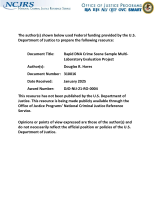Crime Scene
Methods for Obtaining High-Quality Touch DNA from a Nonporous Surface after Latent Fingerprint Collection
Rapid DNA Crime Scene Sample Multi-Laboratory Evaluation Project
Advanced Crime Scene Analysis
George Mason University and the National Association of Attorneys General presents the National Center on Forensics Continued Training Plan
See the YouTube Terms of Service and Google Privacy Policy
Elucidation of the Effect of Solar Light on the Near-Infrared Excitation Raman Spectroscopy-Based Analysis of Fabric Dyes
Advanced Crime Scene Analysis
,
Criticality of Spray Solvent Choice on the Performance of Next Generation, Spray-Based Ambient Mass Spectrometric Ionization Sources: A Case Study Based on Synthetic Cannabinoid Forensic Evidence
Machine Learning Analysis on Gunshot Recognition
Direct Comparison of Body Fluid Identification Technologies
Non-Contact Detection of Fentanyl and Other Opioids: Towards a Generalized Approach to Detection of Dangerous Drug Classes
Stage Transitions in Lucilia sericata and Phormia regina (Diptera: Calliphoridae) and Implications for Forensic Science
Raman Spectroscopy for the Time since Deposition Estimation of a Menstrual Bloodstain
Assessing Stress Among Medicolegal Death Investigators & Building Resilient Medicolegal Professionals
,
A Universal Method for the Detection of Gunshot Residue using Vibrational Spectroscopy
A Comparative Evaluation of the MinION and MiSeq Sequencing Platforms for the Analysis of Human Hand Microbial Profiles for Forensic Investigations.
Semi-empirical Kinetics Model for Fingerprint Aging
Near-infrared Excitation Raman Spectroscopy of Colored Fabric Contaminated with Body Fluids
Rheological Behavior of Brain Tissue: Experiments vs Theory and Forensic Applications
Closing Cases Using Gunshot Residue
Not every crime scene will have definitive evidence, such as DNA, to link an individual to a crime. In those cases, law enforcement relies on other evidence to build the burden of proof. NIJ graduate research fellow Dr. Shelby Khandasammy developed a tool to analyze organic gunshot residue and distinguish between different firearms calibers and manufacturers. She joins Marie Garcia, office director for the Office of Criminal Justice Systems at NIJ, to talk about her work and experience as a research fellow.




